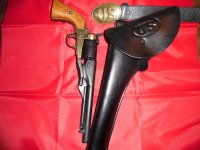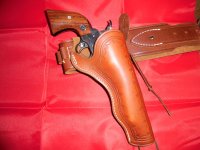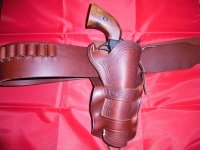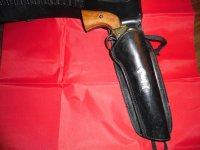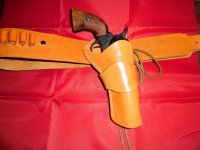Prior to the Civil War mounted infantry called Dragoons carried
their huge revolvers in pouches slung over their saddle pommels
with one or more revolvers on either side, and flaps to keep their
powder dry.
By the time of the Civil War revolvers were carried in flap
holsters on the belt, strong side, with butt foreward. They could
either reach across their body to draw with their weak hand, or
twist their strong side hand to an inverted position, palm out, to
grasp the stock and draw their revolver. Their sabre was carried
on the weak side and drawn cross-draw with their strong side
hand. Shown below far left #1 is a replica of the U.S. Cavalry
flap holster and Colt's 1860 Army replica. This type ensemble
was used from Civil War days up until Custer's battle at the
Little Big Horn.
Meanwhile, civilians carried their revolvers tucked into their
sashes. Belts were not in fashion until the 1850s. Smaller
revolvers, pepper boxes, and Derringers were carried in leather
or canvas lined pockets. One of the earliest holsters was made
in the 1850s in San Francisco by Main & Winchester. They
called it the "California", but it was quickly nicknamed the
"Slim Jim". It is simply a pouch with one sewn seam following
the outline of the revolver. Mine, 2nd from left below, is shown
with my New Model Ruger Super Blackhawk .44 magnum.
Civil War veterans folded the flaps back up over their belts or
simply cut the flaps off, so they could have quicker access to
their revolvers. No longer carrying swords, they would use
their inverted strong side hand to grasp the stock and draw
their revolver. Folding the flap over the belt lead to various
"loop" designs such as the Mexican Loop, the Kansas Loop, and
the Denver Loop, to mention a few. Shown below, 3rd from
left, is my Mexican Loop with Colt's Peacemaker replica.
By the 1950s "Buscadero" type holsters were prevalent in the
movies and on television shows. The shows also brought in the
quick draw craze of the 1950s. Ed Bohlin, Arvo Ojala, George
Lawrence, Andy Anderson, and Alfonso Pineda are just a few of
the makers who made many buscadero quick draw rigs.
#4 from left below is a Hunter buscadero rig that I tried to
make into a Paladin rig by adding the Knight. Do you remember
Have Gun Will Travel? I still see it on TV every now and then.
And of course who can forget the "Duke" style holster made so
popular by John Wayne in many western movies. Shown below
far right is my "Duke" rig from Big Texas, with a Peacemaker
replica.
Now, I'm sure many of you have old west rigs much more
beautiful than mine. Let's see them!
their huge revolvers in pouches slung over their saddle pommels
with one or more revolvers on either side, and flaps to keep their
powder dry.
By the time of the Civil War revolvers were carried in flap
holsters on the belt, strong side, with butt foreward. They could
either reach across their body to draw with their weak hand, or
twist their strong side hand to an inverted position, palm out, to
grasp the stock and draw their revolver. Their sabre was carried
on the weak side and drawn cross-draw with their strong side
hand. Shown below far left #1 is a replica of the U.S. Cavalry
flap holster and Colt's 1860 Army replica. This type ensemble
was used from Civil War days up until Custer's battle at the
Little Big Horn.
Meanwhile, civilians carried their revolvers tucked into their
sashes. Belts were not in fashion until the 1850s. Smaller
revolvers, pepper boxes, and Derringers were carried in leather
or canvas lined pockets. One of the earliest holsters was made
in the 1850s in San Francisco by Main & Winchester. They
called it the "California", but it was quickly nicknamed the
"Slim Jim". It is simply a pouch with one sewn seam following
the outline of the revolver. Mine, 2nd from left below, is shown
with my New Model Ruger Super Blackhawk .44 magnum.
Civil War veterans folded the flaps back up over their belts or
simply cut the flaps off, so they could have quicker access to
their revolvers. No longer carrying swords, they would use
their inverted strong side hand to grasp the stock and draw
their revolver. Folding the flap over the belt lead to various
"loop" designs such as the Mexican Loop, the Kansas Loop, and
the Denver Loop, to mention a few. Shown below, 3rd from
left, is my Mexican Loop with Colt's Peacemaker replica.
By the 1950s "Buscadero" type holsters were prevalent in the
movies and on television shows. The shows also brought in the
quick draw craze of the 1950s. Ed Bohlin, Arvo Ojala, George
Lawrence, Andy Anderson, and Alfonso Pineda are just a few of
the makers who made many buscadero quick draw rigs.
#4 from left below is a Hunter buscadero rig that I tried to
make into a Paladin rig by adding the Knight. Do you remember
Have Gun Will Travel? I still see it on TV every now and then.
And of course who can forget the "Duke" style holster made so
popular by John Wayne in many western movies. Shown below
far right is my "Duke" rig from Big Texas, with a Peacemaker
replica.
Now, I'm sure many of you have old west rigs much more
beautiful than mine. Let's see them!
Attachments
Last edited:

